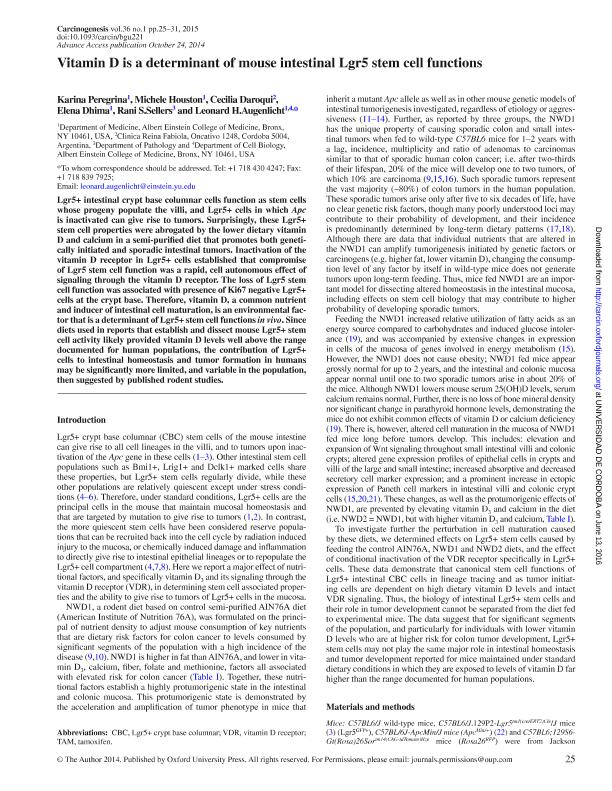Artículo
Vitamin D is a determinant of mouse intestinal Lgr5 stem cell functions
Peregrina, Karina; Houston, Michele; Daroqui, Maria Cecilia ; Dhima, Elena; Sellers, Rani S.; Augenlicht, Leonard H.
; Dhima, Elena; Sellers, Rani S.; Augenlicht, Leonard H.
 ; Dhima, Elena; Sellers, Rani S.; Augenlicht, Leonard H.
; Dhima, Elena; Sellers, Rani S.; Augenlicht, Leonard H.
Fecha de publicación:
01/2015
Editorial:
Oxford University Press
Revista:
Carcinogenesis
ISSN:
1460-2180
Idioma:
Inglés
Tipo de recurso:
Artículo publicado
Clasificación temática:
Resumen
Lgr5+ intestinal crypt base columnar cells function as stem cells whose progeny populate the villi, and Lgr5+ cells in which Apc is inactivated can give rise to tumors. Surprisingly, these Lgr5+ stem cell properties were abrogated by the lower dietary vitamin D and calcium in a semi-purified diet that promotes both genetically initiated and sporadic intestinal tumors. Inactivation of the vitamin D receptor in Lgr5+ cells established that compromise of Lgr5 stem cell function was a rapid, cell autonomous effect of signaling through the vitamin D receptor. The loss of Lgr5 stem cell function was associated with presence of Ki67 negative Lgr5+ cells at the crypt base. Therefore, vitamin D, a common nutrient and inducer of intestinal cell maturation, is an environmental factor that is a determinant of Lgr5+ stem cell functions in vivo. Since diets used in reports that establish and dissect mouse Lgr5+ stem cell activity likely provided vitamin D levels well above the range documented for human populations, the contribution of Lgr5+ cells to intestinal homeostasis and tumor formation in humans may be significantly more limited, and variable in the population, then suggested by published rodent studies.
Palabras clave:
Vitamind
,
Lgr5
,
Stemcell
Archivos asociados
Licencia
Identificadores
Colecciones
Articulos(IIBYT)
Articulos de INSTITUTO DE INVESTIGACIONES BIOLOGICAS Y TECNOLOGICAS
Articulos de INSTITUTO DE INVESTIGACIONES BIOLOGICAS Y TECNOLOGICAS
Citación
Peregrina, Karina; Houston, Michele; Daroqui, Maria Cecilia; Dhima, Elena; Sellers, Rani S.; et al.; Vitamin D is a determinant of mouse intestinal Lgr5 stem cell functions; Oxford University Press; Carcinogenesis; 36; 1; 1-2015; 25-31
Compartir
Altmétricas



